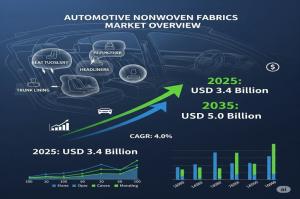Automotive Nonwoven Fabrics Market to Soar USD 5.0 Billion by 2035 with Lightweight, High-Performance Solutions
UK’s automotive nonwoven fabrics market grows at 3.8% CAGR, driven by lightweight materials, custom interiors, and advanced textile shaping systems.
NEWARK, DE, UNITED STATES, August 8, 2025 /EINPresswire.com/ -- The global automotive nonwoven fabrics market is on track to grow from USD 3.4 billion in 2025 to USD 5.0 billion by 2035, achieving a steady CAGR of 4.0%. This growth is driven by the industry’s urgent need for lightweight, durable, and cost-effective materials that meet stringent environmental regulations, improve fuel efficiency, and elevate vehicle performance.
With rising consumer expectations for comfort, safety, and sustainability, automotive nonwoven fabrics are emerging as a critical enabler of next-generation vehicle designs, particularly in interior, thermal, and filtration applications.
A Market Built Around Manufacturer Challenges
Manufacturers across the automotive value chain face a convergence of pressures: emission reduction mandates, fuel economy targets, noise reduction demands, and the shift toward electric and hybrid vehicles. Nonwoven fabrics are uniquely positioned to address these issues through:
• Lightweighting for efficiency – reducing vehicle mass to enhance performance and meet global emission standards.
• Acoustic and thermal control – creating quieter, more comfortable cabins and managing heat in advanced powertrain systems.
• Design flexibility and scalability – adapting to multiple applications, from interior trims to under-hood insulation, with streamlined manufacturing integration.
• Sustainability alignment – offering recyclable, bio-based, and eco-certified solutions without compromising durability.
Key Market Leaders Driving Innovation
The competitive landscape features prominent global players including Freudenberg Performance Materials, Ahlstrom-Munksjö, Kimberly-Clark Corporation, DuPont de Nemours, Lydall, Hollingsworth & Vose Company, Toray Industries, Mitsui Chemicals, Berry Global Group, and Asahi Kasei Corporation.
These companies deliver engineered textile solutions tailored to critical vehicle applications—from premium headliners and carpets to high-efficiency filtration and advanced acoustic barriers—meeting rigorous performance, safety, and regulatory requirements.
Segment Insights: Polyester and Spunbond Lead the Way
Polyester, commanding 36.2% of the market in 2025, remains the preferred material due to its strength, cost-effectiveness, moisture resistance, and recyclability. It supports a range of molding and bonding techniques, making it indispensable for interior, insulation, and reinforcement applications.
In technology, spunbond holds a 29.8% share, producing high-strength, dimensionally stable fabrics ideal for carpets, headliners, and insulation barriers. Its compatibility with synthetic polymers and cost-efficiency in high-speed production make it a manufacturer favorite.
Applications Powering Market Expansion
The interior trim segment, with a 21.6% share, reflects how nonwoven fabrics enhance vehicle cabins with lightweight, customizable, and acoustically optimized components. From headliners to trunk liners, these fabrics are meeting the rising demand for premium, quiet, and comfortable interiors, especially in electric vehicles, where noise reduction is paramount.
Beyond interiors, engine bay and thermal applications are gaining traction, with nonwoven composites providing heat shielding, oil resistance, and noise control in compact, high-performance engine layouts. In filtration, their fine fiber structures support cleaner cabin air, efficient powertrain operation, and reliable EV battery cooling.
Regional Growth Hotspots
The market’s expansion is underpinned by regional strengths:
• China – Leading with a 5.4% CAGR, driven by large-scale production and polyester-polypropylene blends for cost and thermal performance.
• India – Growing at 5.0% CAGR, with strong adoption in compact and mid-size segments, supported by regional thermoforming facilities.
• Germany – At 4.6% CAGR, excelling in premium automotive interiors with engineered, fire-retardant, and recyclable fabrics.
• United Kingdom – Growing at 3.8%, focusing on lightweight trims, parcel shelves, and acoustic panels for compact and hybrid models.
• United States – At 3.4% CAGR, sustained by applications in SUVs, light trucks, and passenger cars with strong OEM and aftermarket demand.
Aligning with Automotive Production Strategies
Nonwoven fabrics directly support modular production and cost reduction strategies by enabling integrated part manufacturing, reducing assembly steps, and cutting labor and logistics costs. Their compatibility with automated systems allows for high throughput and consistent quality, critical for smart factory and just-in-time manufacturing environments.
Recent Industry Developments
• AJ Nonwovens relaunched Multipile (July 17, 2025), a versatile aftermarket solution for insulation, trim, and performance liners, delivering superior acoustic and thermal properties.
• AGC introduced FibraLAST at IDEA® 25 (April 29–May 1, 2025), a non-fluorinated oil and water repellent coating for automotive and technical nonwoven fabrics, combining strong barrier performance with sustainability certification.
Request Automotive Nonwoven Fabrics Market Draft Report:
https://www.futuremarketinsights.com/reports/sample/rep-gb-22829
For more on their methodology and market coverage, visit https://www.futuremarketinsights.com/about-us.
Why Manufacturers Should Act Now
The decade ahead presents a pivotal opportunity for automotive manufacturers to adopt nonwoven solutions that solve current challenges and prepare for future vehicle architectures. Nonwoven fabrics’ blend of performance, adaptability, and sustainability positions them as a material platform that can evolve alongside industry trends—from electrification to autonomous interiors.
Manufacturers that integrate these solutions early stand to benefit from:
• Enhanced compliance with global emissions and recyclability standards
• Greater design freedom for differentiated interiors and components
• Lower total cost of production through modular part integration
• Stronger positioning in both OEM and aftermarket channels
Related Insights from Future Market Insights (FMI)
Nonwoven Polyester Fabric Market - https://www.futuremarketinsights.com/reports/nonwoven-polyester-fabric-market
Coated Fabrics Market - https://www.futuremarketinsights.com/reports/coated-fabrics-market
Automotive Fabrics Market - https://www.futuremarketinsights.com/reports/automotive-fabric-market
Waterproof Fabrics Market - https://www.futuremarketinsights.com/reports/waterproof-fabrics-market
Coated Fabrics for Defense Market - https://www.futuremarketinsights.com/reports/coated-fabrics-defense-market
Editor’s Note:
The automotive nonwoven fabrics market is gaining momentum, driven by the demand for lightweight, durable, and sustainable interior solutions. Manufacturers are leveraging advanced textile technologies to enhance comfort, performance, and customization in vehicle design. With steady growth projected, this sector remains pivotal in shaping the future of eco-friendly and high-performance automotive interiors.
Rahul Singh
Future Market Insights Inc.
+1 347-918-3531
email us here
Legal Disclaimer:
EIN Presswire provides this news content "as is" without warranty of any kind. We do not accept any responsibility or liability for the accuracy, content, images, videos, licenses, completeness, legality, or reliability of the information contained in this article. If you have any complaints or copyright issues related to this article, kindly contact the author above.

